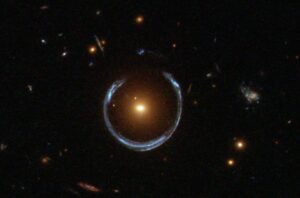Astronomers may have come across something extraordinary. A supermassive black hole “switched on” to become one of the brightest transient objects ever detected.
The gigantic black hole is approximately 10 billion light years away from Earth. Astronomers first spotted J221951 in 2019, but the research on it has only just become public.
Because the black hole is so far away, the event would actually have occurred when the universe was only one quarter of its current age.
A team of astronomers led by researchers from @unibirmingham, @ucl, and @QUBelfast have discovered one of the most dramatic ‘switches on’ of a black hole ever seen.
They will present their findings today at #NAM2023 in Cardiff. pic.twitter.com/6RSx0fpONi
— Royal Astronomical Society (@RoyalAstroSoc) July 4, 2023
The discovery began when the researchers came across the path of a gravitational wave — a ripple in space-time from a collision in space. They began searching for a kilonova, an explosion that occurs when two neutron stars or a neutron star and a black hole merge.
But it soon became clear that J221951 was something else. Kilonovas are blue and fade to red in a few days. This stayed bright blue for months. A single explosion could not have caused it.
Several telescopes observed the mysterious object for months. It lined up almost perfectly with the center of another galaxy. This suggested that it could be a supermassive black hole like Sagittarius A*, the one at the core of our own galaxy.
Ten months after it suddenly lit up, it started to fade. This showed that it wasn’t the center of a galaxy, bur rather a transient object in space. Astronomers believe that they were watching a black hole “switch on.” Black holes can switch on and off during their lifetime. It depends how much matter is available for them to feed on.

A NASA illustration of a tidal disruption event. Image: NASA/JPL-CALTECH
Two possible triggers
There are two possible triggers for the event. The first is that the previously dormant black hole became active and started rapidly feeding on the surrounding matter. No one is sure why this happens.
The second is that a tidal disruption event occurred. In this scenario, a star passed too close to the hole. Its tidal forces ripped it apart, then the black hole consumed it.
Scientists will continue to monitor it. If it lights up again, the cause is likely the first trigger — that every time the hole starts feeding, it lights up. However, if it continues to fade, then the other possible cause, the tearing apart of a star, is more likely.
“Our understanding of the different things that supermassive black holes can do has greatly expanded in recent years, with discoveries of stars being torn apart and accreting black holes with hugely variable luminosities,” said astronomer and co-author Matt Nicholl. “J221951 is one of the most extreme examples yet of a black hole taking us by surprise.”






